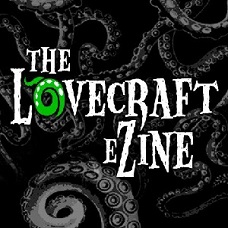I received Under Twin Suns: Alternative Histories of the Yellow Sign as a Christmas present and read it in only a few days. Unfortunately, January and February were busy months, and I couldn’t finish my review of this anthology until now. In the time since I read Under Twin Suns, it made the final ballot for the 2021 Bram Stoker Awards. Congratulations are in order for the editor, James Chambers, publisher, Hippocampus Press, and all the authors. The Bram Stoker nomination is a well-deserved accolade for this fantastic collection.
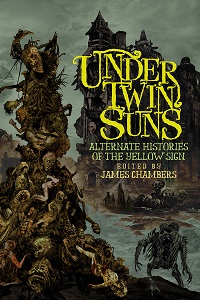
I’m an avid fan of Robert W. Chamber’s The King in Yellow. I’ve written a few tales loosely connected to the King in Yellow, and I even took a trip to visit the author’s grave in Broadalbin, New York. Suffice it to say, when I first heard about Under Twin Suns, I was excited by the prospect of an anthology consisting of King in Yellow-inspired stories. My excitement only doubled when I found out some of my favorite authors, such as John Langan, had tales included.
Per the advice of James Chamber’s introduction, I read this collection from front to back. It’s a testament to the quality of the work in Under Twin Suns that I was able to do that with no issue. I often find that anthologies have ebbs and flows, like a novel, and some stories prove to be more or less engaging based on your mindset while you’re reading. Occasionally, you may even skip a tale to revisit. There wasn’t a single story in Under Twin Suns that didn’t hold my interest. I read each one and moved right to the next until I was finished.
I’ve listed a few of my favorite tales in this collection below, but I wanted to note again that each work included in Under Twin Suns is great. These stories are just the ones that resonated most with me on my first reading. “Robert Chambers Reads The King in Yellow” by Lisa Morton is the first tale, and I loved the meta nature of it. “The King in Yella” by Kaaron Warren felt like a modern take on Karl Edward Wagner’s “The River of Night’s Dreaming.” “The Yellow House” by Greg Chapman ramped up to a stunningly insane climax. “Freedom for All” by JG Faherty felt topical as it dealt with a conspiracy theory driven cult. “Y2K” by Todd Keisling gets props for bringing David Bowie into the King in Yellow mythos. “Veiled Intentions” by Linda D. Addison was an excellent poetic inclusion. Lastly, “The Exchange” by Tim Waggoner was a perfectly Twilight Zone-esque story with a wonderful ending.
If you haven’t read Under Twin Suns yet, I highly recommend you pick up a copy. That said, be sure you’ve read at least “The Yellow Sign” and “The Repairer of Reputations” by Robert W. Chambers before you dive into this anthology. I’m sure you can still enjoy this collection if you’re not familiar with those tales, but you’ll get a lot more out of each author’s work with some prior knowledge of The King in Yellow. If you need a taste of Chamber’s prose before picking up his work, you can check out this video, where I read an excerpt from his story “The Yellow Sign” while visiting the author’s final resting place.




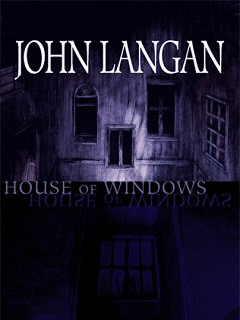 While House of Windows seems like a haunted house story at first glance, it’s actually more of a haunted father story. The novel’s primary conflict stems from a curse that Veronica’s husband, Roger, places on his son, Ted. Roger places the curse on Ted after the two get into a physical fight over the fact that Roger left Ted’s mother to marry Veronica, his college student. Due to Ted’s death soon after the curse, Roger is unable to reconcile with his son, and Veronica is soon haunted by visions and reminders of Ted, figuratively and literally. Ted’s death breaks Roger, and to try to be closer to his lost son, Roger decides to move him and Veronica into the home where he raised Ted, Belvedere House. Once in Belvedere House, Roger becomes increasingly obsessed with his lost son’s death, and Ted’s haunting of Veronica gets progressively more intense until the novel’s climax, where Roger disappears during a supernatural event. There’s a lot I’m leaving out, but that’s the bare-bones summary of the book.
While House of Windows seems like a haunted house story at first glance, it’s actually more of a haunted father story. The novel’s primary conflict stems from a curse that Veronica’s husband, Roger, places on his son, Ted. Roger places the curse on Ted after the two get into a physical fight over the fact that Roger left Ted’s mother to marry Veronica, his college student. Due to Ted’s death soon after the curse, Roger is unable to reconcile with his son, and Veronica is soon haunted by visions and reminders of Ted, figuratively and literally. Ted’s death breaks Roger, and to try to be closer to his lost son, Roger decides to move him and Veronica into the home where he raised Ted, Belvedere House. Once in Belvedere House, Roger becomes increasingly obsessed with his lost son’s death, and Ted’s haunting of Veronica gets progressively more intense until the novel’s climax, where Roger disappears during a supernatural event. There’s a lot I’m leaving out, but that’s the bare-bones summary of the book.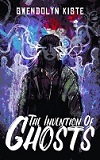
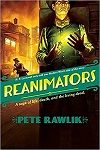 For a while, I’d been thinking, why hasn’t anyone done a story that pulls together a bunch of Lovecraft’s connected mythos into a singular tale? Well, I had somehow foolishly missed out on Reanimators existence until recently. The novel weaves the tale of Dr. Stuart Hartwell, a contemporary of Herbert West, as he moves through the years in and around Arkham. In the narrative, Hartwell encounters several of Lovecraft’s most famous characters and even intersects with several of Lovecraft’s best tales. This was a ton of fun to read, and I can’t wait to dive into the sequel. Maybe one day I’ll do a post trying to diagram out all the references and Easter eggs. Indiana Jones even pops up in the text.
For a while, I’d been thinking, why hasn’t anyone done a story that pulls together a bunch of Lovecraft’s connected mythos into a singular tale? Well, I had somehow foolishly missed out on Reanimators existence until recently. The novel weaves the tale of Dr. Stuart Hartwell, a contemporary of Herbert West, as he moves through the years in and around Arkham. In the narrative, Hartwell encounters several of Lovecraft’s most famous characters and even intersects with several of Lovecraft’s best tales. This was a ton of fun to read, and I can’t wait to dive into the sequel. Maybe one day I’ll do a post trying to diagram out all the references and Easter eggs. Indiana Jones even pops up in the text. Silver Bullet is one of my favorite horror films of all time. A big part of why I love this movie so much is tied to the fact that I saw it at a young age, but I also think it’s a brilliant gem. The way the movie builds dread as it slowly progresses toward the climax, the excellent performances, and the way the werewolf’s killings impact the small town of Tarker’s Mill combine to make Silver Bullet special. So, it was only a matter of time until I read Cycle of the Werewolf. While I enjoyed the novella, I felt the story worked better as a screenplay. The close bonds between Marty and his sister, and Marty and his uncle, weren’t present in Cycle of the Werewolf, and they’re a major reason why I love Silver Bullet. The story felt hollow without them. Although, the movie didn’t have the stellar art by Bernie Wrightson.
Silver Bullet is one of my favorite horror films of all time. A big part of why I love this movie so much is tied to the fact that I saw it at a young age, but I also think it’s a brilliant gem. The way the movie builds dread as it slowly progresses toward the climax, the excellent performances, and the way the werewolf’s killings impact the small town of Tarker’s Mill combine to make Silver Bullet special. So, it was only a matter of time until I read Cycle of the Werewolf. While I enjoyed the novella, I felt the story worked better as a screenplay. The close bonds between Marty and his sister, and Marty and his uncle, weren’t present in Cycle of the Werewolf, and they’re a major reason why I love Silver Bullet. The story felt hollow without them. Although, the movie didn’t have the stellar art by Bernie Wrightson.



